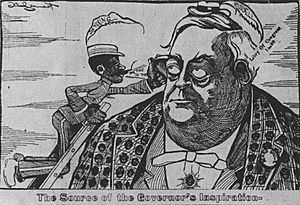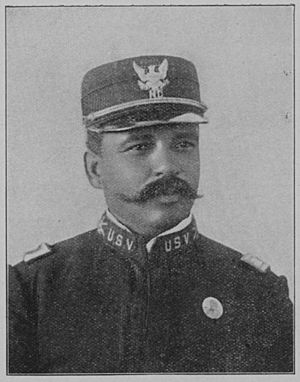Third North Carolina Regiment (1898–1899) facts for kids
The Third North Carolina Regiment was a special military unit from North Carolina during the Spanish–American War in 1898. What made it unique was that it was made up entirely of African American soldiers and, very unusually for the time, all its officers were also African American. Even though they were ready to serve, the regiment did not fight in any battles. Instead, they spent their time training in camps in North Carolina, Tennessee, and Georgia.
Contents
Why the Regiment Was Formed
When the Spanish–American War started in 1898, African Americans had mixed feelings. Many faced unfair treatment and discrimination in the United States. They wondered why they should fight for a country that didn't treat them equally. However, others, especially leaders in places like Wilmington, North Carolina, saw the war as a chance to show their courage and love for their country. They hoped this would help white Americans see them differently.
After the American Civil War, most black military groups in North Carolina were shut down. By 1898, there was only one small group of 40 black soldiers left in the state's military. When President William McKinley asked for volunteers, the government set goals for each state to create new units. In the regular United States Army, black men could only serve in separate regiments led by white officers, or in support roles like cooks. Because of this, many black men hoped to join the new volunteer units where they might have better opportunities.
North Carolina's governor at the time was Daniel Lindsay Russell, a Republican. He had been elected with a lot of support from African American voters. When the war began, some black leaders who had formed their own informal military groups asked Governor Russell to make them official parts of North Carolina's contribution to the war effort.
The United States Department of War had asked North Carolina for two white infantry regiments and an artillery unit. Governor Russell, remembering the support he got from black voters, sent his advisor, J. C. L. Harris, to Washington D.C.. Harris's job was to convince the War Department to either swap the artillery unit for a black infantry battalion or allow an all-black regiment to be formed. Other important leaders, like Senator Marion Butler and Congressman George Henry White, also helped. They argued that black soldiers could handle the hot climate of Cuba and were eager to join. Even though the War Department first said no, these leaders kept pushing.
The Regiment's Service
How the Regiment Was Created
Governor Russell eventually convinced the federal government to let North Carolina create a black infantry battalion instead of an artillery unit. On April 27, 1898, he announced the creation of this battalion. He put James H. Young, a well-known black political leader and his ally, in charge. Young was given the rank of major. Black newspapers across the country praised Governor Russell for this decision, especially because he chose a black officer to lead the unit. People started calling it "Russell's Black Battalion."
J. C. L. Harris then encouraged the governor to make the battalion even bigger, turning it into a full regiment. He told Russell that President McKinley and Secretary of War Russell A. Alger actually wanted North Carolina to have a full black regiment, even if they wouldn't say so officially. Harris warned that not doing so could cost Russell political support. So, when President McKinley asked for more volunteers in May, Governor Russell announced that he was expanding the battalion into a full regiment.
Governor Russell ordered Major Young to recruit seven more companies of soldiers. These new companies would join Young's battalion to form the Third North Carolina Infantry, United States Volunteers. Many men wanted to join Young's unit, while one of the white units struggled to find enough soldiers. Once all the companies were ready, the regiment gathered in Raleigh and then traveled by train to Fort Macon for training.
Even though there was pressure to appoint white officers, Governor Russell announced on June 28 that all the officers for the regiment would be African American. James H. Young remained in charge and was promoted to colonel. S. L. A. Taylor became his second-in-command. This made North Carolina one of only three states to create a black-officered regiment for the war. The regiment had 1,108 men and officers.
Political Challenges

During the 1898 elections, the Democratic Party tried to remove Governor Russell's political group from power. They ran a campaign that criticized "Negro domination." Democratic newspapers attacked Governor Russell for giving guns to black soldiers. They said he chose officers for political reasons, not military skill, and accused him of favoring his "pet regiment."
Josephus Daniels, the editor of the Raleigh The News & Observer newspaper, admitted that Young was intelligent but still criticized him and his men. Daniels even accused Young of trying to avoid sending the regiment to Cuba so he could stay close to Raleigh for political reasons. The state's Adjutant-General, Andrew D. Cowles, also claimed that many of the regiment's initial volunteers had backed out because they were scared after hearing about heavy losses in battles. Black leaders disagreed, pointing out that regular black army units had fought bravely and that it was actually hard to find enough white volunteers in the state.
Training and Tensions
At Fort Macon, the soldiers trained hard. The officers knew that because their unit was made up of African American soldiers, it would be watched very closely. Despite this, the regiment faced some of the same challenges and rule-breaking issues as other volunteer units. When the fighting in Cuba ended in mid-1898, the soldiers' spirits dropped. They had expected to fight, and now they thought they would only be doing guard duty. Soldiers started complaining that their officers, especially Colonel Young, were too strict.
Fort Macon was a bit isolated, but soldiers were allowed to visit nearby cities like Wilmington, New Bern, and Morehead City. White residents in these towns were uneasy about the black soldiers' presence and were annoyed by their requests for "equal treatment." One newspaper even reported that the soldiers' actions in Morehead City almost caused a major conflict, which was only stopped by authorities.
On September 17, the Third Regiment moved to Camp Poland, near Knoxville, Tennessee. There, they joined another black regiment and a white regiment. Another white unit was also at the camp. Relations between the North Carolinians and the white Georgians were tense. The Georgians would throw rocks at the black soldiers during drills and even shoot at them if they went into the woods. An Ohio company was ordered to protect the Third Regiment. Even after the Georgians left, complaints about misbehavior were often blamed on the North Carolinians. Many white people believed that a unit with black officers could not maintain discipline.

Knoxville newspapers were initially critical of the Third Regiment. However, over time, they began to appreciate the soldiers' drilling and good behavior when visiting the city. The Knoxville Journal reported that the men knew they were being watched and wanted to earn respect as true soldiers. Still, the unit's morale continued to suffer. Soldiers grumbled about Colonel Young's strict discipline. Camp Poland also lacked enough supplies and clean water, which Young reported to his superior.
In October, it was announced that the Third Regiment would move to Camp Haskell near Macon, Georgia. Many soldiers were unhappy about the racial atmosphere in Georgia and the Deep South. Some even hoped the unit would be sent to Cuba to avoid discrimination. Morale dropped further after the Democrats won many elections in North Carolina in early November. This was soon followed by the Wilmington massacre on November 10, an event that involved a white unit that had already been released from federal duty.
The Third Regiment left Camp Poland for Georgia on November 23. About 4,000 black volunteers were stationed at the camp, which caused significant complaints from local white residents. Local white newspapers and the Governor of Georgia claimed the black troops were badly behaved and caused violence. Most of this criticism was aimed at the Third Regiment because it had black leaders. The Atlanta Journal wrote that they were "a tougher and more turbulent set of Negroes."
Charles F. Meserve, the president of Shaw University in Raleigh, was curious about the negative news. He decided to visit Camp Poland without announcing himself in late December. Many of the soldiers and officers were his former students. Meserve toured the Third Regiment's living areas and interviewed white staff officers. He reported that the barracks were "well nigh perfect" in terms of cleanliness. He also said that the white military police chief thought highly of the unit's discipline. Captain J. C. Gresham, a white officer, even said that Colonel Young was "a more capable man." Despite Meserve's positive report, white criticism of the regiment in the press continued. Sadly, four soldiers were killed by white Georgians, who were later excused in court.
Disbanding the Regiment
In January 1899, it was announced that the Third Regiment would be released from service. The soldiers were officially discharged in the first week of February and traveled by train from Macon to Raleigh. Authorities in Macon warned leaders in Atlanta that the black veterans might cause trouble. So, on the day they arrived in Atlanta, a large group of police officers surrounded the train station. They boarded the train, looking for a supposed "ringleader," and in the process, they hit many soldiers with clubs. A civilian passenger on the train reported that there were no problems before the police arrived.
What Happened Next
After the regiment was disbanded, Edward A. Johnson, a black leader in Raleigh, asked the North Carolina General Assembly (which was now controlled by Democrats) to honor the black soldiers who had served their country. His request was ignored. Instead, in 1899, the state legislature passed a law that prevented black people from serving in the State Guard. They also removed James H. Young's name from the cornerstone of a state school for people with disabilities, a school he had helped create when he was a legislator. The next year, the General Assembly changed the state constitution in a way that effectively stopped most black voters from casting their ballots.
James H. Young later worked for the federal government as a tax collector. Five other former officers from the Third Regiment joined all-black units that fought in the Philippine–American War. Many years after the Spanish–American War, Josephus Daniels, the newspaper editor who had criticized the regiment, admitted that the men of the regiment "made much better soldiers than anybody expected."
Images for kids


